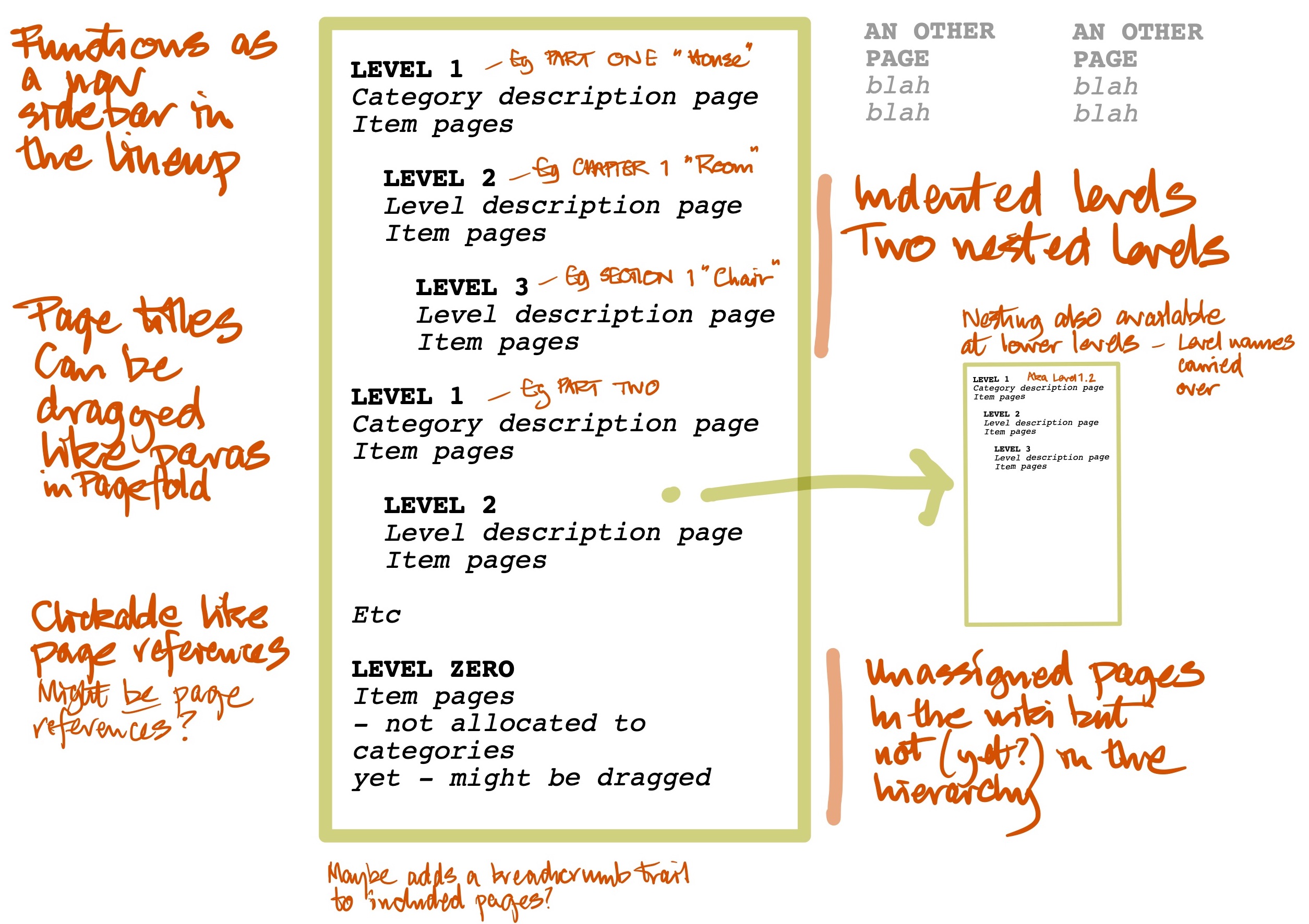A handbook has a set of top-level categies that define its sections. For example, in an assemblage of protocols (aka patterns) in the practice of a commons, there might be three main categories.

Contributions in a commons - An ontology
A 'nest' paragraph can be envisaged, in which the top-level structure is represented, and page titles (clickable links) can be dragged into place within one or another section, in a particular sequence. It can be pictured as working something like the Pagefold plugin works within a page, with draggable paragraphs.

A 'nest' paragraph in a wiki lineup
In the page lineup, the 'nest' page functions like a nav sidebar. Different nest pages, at different places within the lineup, would display local nesting.
Because the practice being described in the handbook is intrinsically complex - a 'weave' or 'dance' of many kinds of protocol and substance - inter-page links will not remain within categories/sections. But a straight readthrough ought to be facilitated, in any of the main divisions of content: this is what the 'nest' page is for.
Is there any need to 'linearise' such sets of pages within categories? Is this an attempt to flatten an intrinsically distributed network? Well, a sequence may help with scanning and reading, in a way that a branching graph does not?
> Sometimes, there might be a preferred sequence of reference - as in a handbook perhaps. But this is not necessarily a hierarchy, perhaps more a narrative sequence; or a system of logical precedence. For their power and usability (and delight) pattern languages depend partly on such narrative sequences, both locally (within pattern families) and globally (in their gross 'ontological' structure).
The three-way division of sections above, for example, springs directly from the nature of a commons - that is, a commons ontology - constituted in three kinds of contributory practice: provisioning, enjoying, stewarding. A reader would want at some point to read about each of these, to grasp the distinctiveness of each of them. But at another time, they would want to follow the 'dance' of interconnections between the elements engaged by THIS page, and THIS page, indiscriminately across all the three 'modes'.
A requirement for nesting is a requirement for 'a book' per se: multiple chunks of material, presented in a particular sequence under a particular (didactic, narrative, etc) rationale. An example is From economics to organising - a rather long essay, with a rather hypertextual, modular form.
Above we have visualised a tool for manually organising pages within a nesting system of categories, for ease of reference: effectively, a nav sidebar. Perhaps another approach would be to automatically generate such a representation from category-tags embedded in pages. Conversely, perhaps the 'nest' tool would embed a tag in a page - or even, generate a clickable breadcrumb trail for the location of the page within the category system, and write it as a paragraph into the page. Perhaps it would embed a paragraph comprising 'Previous' and 'Next' links.
In other words, sometimes we might want to perform operations IN the representation, manipulating it, moving tokens (page links) within it. And sometimes we might want to operate (or read) in an encoded textual space: using tags and categories within the body of a page.
In what way is this kind of capability with the **textual content** of pages more helpful than the existing tools at page level - "x pages link here" - or site level: a roster?
A roster includes a provision for 'categories'. So we need to develop some thoughts on how far rosters contribute to the aim in view here, and what it is that they don't yet do. Rosters and categories
'X pages link here' is very powerful. But to develop this, we need to think about visualisations of levels 'up' and levels 'down' in a cascade of pattern relationships. This takes us into Graphviz territory. Category elements within a pattern Note however, that that page brings us back here: a 'nest' tool and a graph tool complement each other, as means of visualising and navigating?
Similarly, Lineup diagram template does some work of this kind. But when the neighborhood is complex, it doesn't give any sense of the desired narrative movement at this place in the network. Or what we might call the poetic quality of this page's subject, it's 'colour' or 'texture', in relation to colours and textures of other pages' content.
It seems clear, we are concerned at this point with the reading of the texual content of pages - what they say or show or invoke - rather than the structural relationships between pages and page topics. It's no longer an outline of a handbook we're considering. It's something more like . . a concordance?